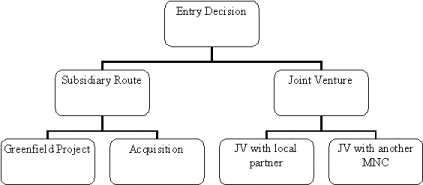|
Previous
Part - II
The mode of entry for all companies will be eventually determined by the government policy and regulatory environment of the host country. If the government policy is FDI friendly then the companies should enter through the subsidiary route. Also, if the regulatory environment of a host country is not stable then the MNC should enter through JV route to reduce its risks.
The companies that plan to enter through subsidiary route should look at acquisitions if there are good target firms, some good privatization is taking place, and when there is a need to gain market faster. Otherwise the companies should prefer the Greenfield project route.
1. Introduction
The last two decades have witnessed an extensive growth in foreign direct investment (FDI) flows to the emerging economies. The FDI to all emerging markets increased from USD 19.7 billion in 1990 to USD 129 billion in 2002*. The share of developing countries of the total world FDI was 27.86 percent in 2003**.
Emerging markets play a pivotal role in the global strategies of many multi national companies (MNCs), mainly those with ambitious growth targets. Moreover expanding the firm's assets internationally facilitates the diversification of both costs and revenues, which is very important for smoothing profitability when currency values are so volatile.
2. Entry Modes for FDI
The MNCs that plan to enter a host country (country getting FDI) makes the decision on the entry mode as shown below: -

Next
* UNCTAD database, World Bank.
** UNCTAD 2003 Total FDI flows are divided between developed countries, developing countries and Central and Eastern Europe.
* Contributed by: -
Abhishek Gupta & Anurag Ghuwalewala,
PGP-2, Batch 2003-2005,
IIM Bangalore.
|